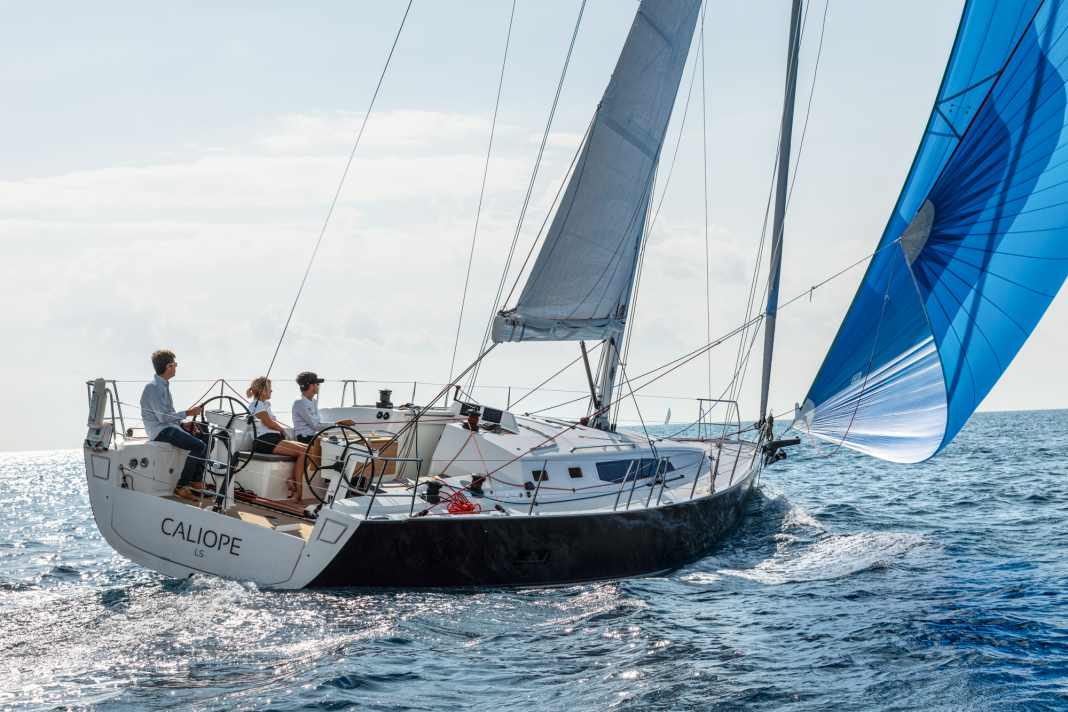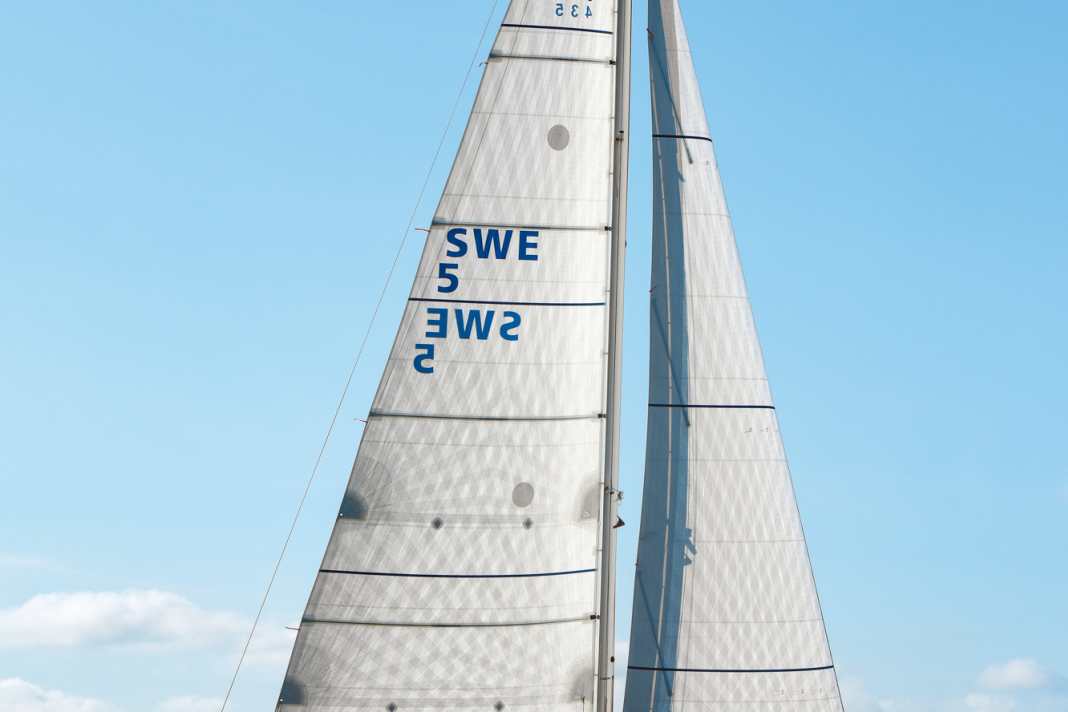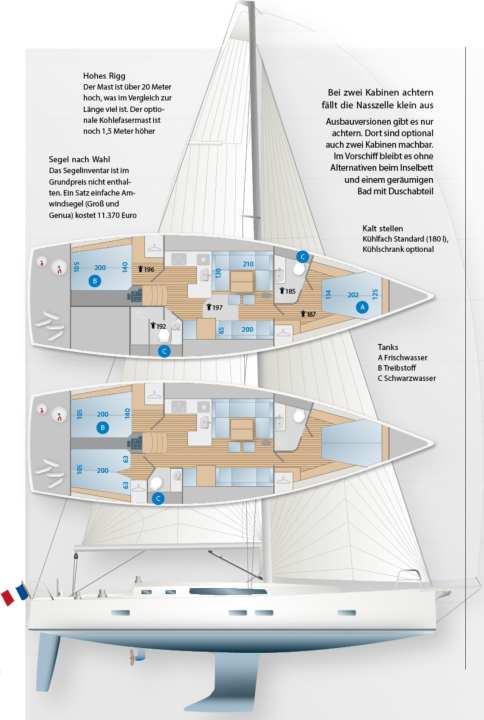





Based in Newport, J/Boats is the only US brand to have established a market-relevant presence in Europe over the years. This is also due to the fact that J Composites has had a strong production branch in western France for some time. In fact, the shipyard in Les Sables-d'Olonne currently produces the vast majority of all J boats, i.e. around 80 per cent of total sales, or around 200 boats a year.
What's more, the French are not only building under licence from J/Boats for sale in Europe, but are also largely involved in the development of new models - as is now the case with the J/45. Although the construction plans naturally still come from the family-run parent company in America and, as usual, from co-president and designer Alan Johnstone, the new ship is being built exclusively in France. Accordingly, it is primarily tailored to the demand of the European market.
Also interesting:
However, this does not mean that J/Boats is breaking with tradition and the tried and tested. Quite the opposite: there are not many manufacturers who have remained so true to their tried and tested brand values over many years. This is particularly evident in the continued unadapted design language. The Johnstones have never wanted to orientate their designs unconditionally to fashion and the zeitgeist, as many of their competitors do. Instead, they have always given their yachts a very independent and unmistakable character. The characteristic features of all J boats: slender hulls, drawn-in sterns, low freeboard, a pronounced deck planing and a sporty basic design.
In search of a compromise: the competition of the J/45





There are many useful details, but not many unnecessary ones
The J/45, the largest boat in the current model range, naturally also fits into this proven design pattern. The attractive fast cruiser belongs to the manufacturer J Composites' upmarket Elegance line, with a much stronger focus on touring suitability and living comfort than the boats in the regatta- and measurement-optimised, but less comfortable Sportboat series. The concept of the J/45 generally presents itself with only a few surprising innovations. One new feature is the fixed bowsprit instead of the long, extendable trunk, which J/Boats may not have invented, but has made more or less acceptable over the years. The carbon spine is available for the J/45 in lengths of either 70 or 140 centimetres. And it is only bolted to the hull and can therefore also be removed.
The shipyard continues to be uncompromising when it comes to the equipment on deck and uses only the premium range for all fittings, winches, rails, guide blocks and clamps. The components are well dimensioned and of the highest quality. Products from Harken have always been part of J/Boats' basic equipment from the shipyard without any alternatives.
The layout in the cockpit corresponds to the pragmatic, tried-and-tested arrangement for performance boats. This means: primary and secondary winches for the genoa and mainsheet on the coaming, plus two more winches on the companionway for halyards, reefing and trim lines. And there is a long traveller on the cockpit floor in front of the steering pillars for the mainsheet guide based on the German-Cupper model. Although the helmsman can operate the mainsheet and traveller himself from his position behind the steering wheel, the large J/45 is still not suitable for single-handed sailing; it requires a crew. The winches for the genoa are also built relatively far outwards and can therefore only be operated directly from the cockpit to a limited extent. Efficient cranking is only possible if you sit astride the coaming.
It is a pleasure to steer the J/45 over the waves
Nominated for European Yacht of the Year 2022, the J/45 was available to YACHT for testing in Barcelona. In medium wind speeds of between 12 and 15 knots, but with a rather high, unpleasant swell, the Johnstone design shows how much sailing potential it has - especially upwind. Despite the waves, it manages 7.4 knots with a short overlapping genoa and full mainsail on the cross at an angle of 40 degrees to the wind direction. However, instead of the standard aluminium rig, the test boat is equipped with the optionally available carbon fibre mast from Axxon Composites, which is around 1.5 metres higher and - because it is stiffer - can also be trimmed more efficiently. The sail area is of course also correspondingly larger.
It is a pleasure to steer the J/45 over the waves. The boat reacts immediately and instantly to even minimal rudder movements. A pleasantly light rudder pressure gives a good feeling and makes it easy to keep the boat optimally on the wind edge - fantastic. A single, continuous cable connects the two steering wheels (only 80 centimetres in diameter) with the very large quadrant for the single rudder. Independently of this, the autopilot is attached directly to the rudder shaft and thus provides additional safety in the event of a mechanical defect in the steering system.
Isabelle Racoupeau designed the interior. Her work is impressive across the board. It is very stylish below deck
For the interior design, J Composites has brought on board the well-booked French interior designer Isabelle Racoupeau, who is also in the service of Hanseyachts. For the J/45, she has created an open, bright and rather straightforward interior, very modern and rich in colour contrasts. As usual, buyers can choose between different types of wood and upholstery fabrics. J Composites obtains the furniture as prefabricated modules from an external supplier. Although the components are beautifully built, they do not fit together perfectly on the test boat (build number 1), which leaves some unsightly gaps and joints. The shipyard wants to work on and improve this for the series. The robust, thick marine plywood floor boards, on the other hand, are laid evenly and also screwed to the floor bearings. Creaking floors are not an issue with the J/45.
As standard ex shipyard, the ship is equipped with one double cabin aft and one forward. A bathroom with shower completes the living facilities for the owners in the foredeck. A second, also very generously planned toilet room with a semi-separate shower area is available aft. As an option, the shipyard can fit the boat with a third double cabin in place of the large starboard side locker, which can also be accessed from the inside. In this case, however, the aft wet room has to give up a lot of space. Judging by the plans, it would then be very small.
A glance at the pricing and that of the competition reveals that the J/45 is no bargain. It is a well-known fact that J/Boats' upmarket pricing policy can also be explained by its extensive and unusually high-quality basic equipment and its elaborate, very robust construction. It remains to be seen whether the good in the package is enough to prevail against the strong competition in this class. However, the solid foundation for this has already been laid.
The measured values for testing the J/45





The J/45 in detail

Technical data of the J/45
- Designer: Alain Johnstone
- CE design category: A
- Torso length: 13,85 m
- Total length: 14,55 m
- Waterline length: 12,56 m
- Width: 4,25 m
- Draught/ageing: 2,30/2,60, 2,10 m
- Theor. torso speed: 8.6 kn
- Weight: 9,9 t
- Ballast/proportion: 4,15 t/42 %
- Mast height above WL: 20,30 m
- Mainsail: 66,0 m2
- Furling genoa (106 %): 49,0 m2
- machine (Volvo P.): 44 kW/60 hp
- Fuel tank: 200 l
- Fresh water tanks (2): 350 l
- Holding tank: 2 x 50 litres
- Batteries: 2 x 100 Ah + 1 x 75 Ah
Hull and deck construction
GRP sandwich with E-glass fibres, balsa wood and foam core and vinyl ester resin. Built using the vacuum infusion process. Composite bulkheads firmly laminated on
Equipment, price and shipyard
- Base price ex shipyard: 603,390 € gross incl. 19% VAT.
- Standard equipment included: engine, sheets, railing, navigation lights, battery, compass, sails, cushions, galley/cooker, bilge pump, toilet, fire extinguisher, electric coolbox, waste-holding tank with suction system
- For an extra charge: Sail (main and genoa), sailcloth, anchor with chain, fenders/mooring, antifouling
- Guarantee/against osmosis: 5/10 years
Included in the price:
Fixed bowsprit with anchor holder, storage compartment for liferaft, hydraulic backstay tensioner, all halyards and lines made of Dyneema
As of 5/2024, how the prices shown are defined can be found here!
Electronics
Scope, quality and brand generally at the owner's request. Shipyard recommendation: Raymarine electronics package with speedo, wind instruments, depth sounder, radio and autopilot
Winches/running rigging
6 x Harken 50.2 STA (two-rope, self-tailing) as standard. Halyards, sheets and trim lines all made of Dyneema material
Motor and gearbox
Standard: Volvo Penta D2-60 with saildrive and three-blade folding propeller. Optional: Volvo Penta D2-75
Rig and sail
Aluminium rig from manufacturer Marechal with two pairs of spreaders. Continuous rod shrouds as standard. Self-tacking jib as an option
Shipyard
J Composites, 85109 Les Sables- d'Olonne (France), www.jcomposites.eu
Distribution
Mittelmann's Werft, 24376 Kappeln; www.mittelmannswerft.de
YACHT rating of the J/45
Fast and sporty sailing and yet extremely comfortable living: The J/45 manages the difficult balancing act masterfully. The concept remains pragmatic and dispenses with supposedly revolutionary innovations - you know what you're getting
Design and concept
- + Straight alignment
- + High-quality construction
- + Attractive appearance
- - Highly priced, but justifiable
Sailing performance and trim
- + Strong performance in the wind
- + Clear deck layout
- + Clear team orientation
- - Accessibility Genuawinschen
Living and finishing quality
- + Attractive interior design
- + Large bathrooms with showers
- - Narrow berths aft and forward
- - Gap dimensions on the prototype
Equipment and technology
- + Impeccable deck equipment
- + Large hatches, good ventilation
- + Very robust control mechanism
- + Removable stainless steel tanks
The article first appeared in YACHT 05/2022 and has been updated for the online version.

